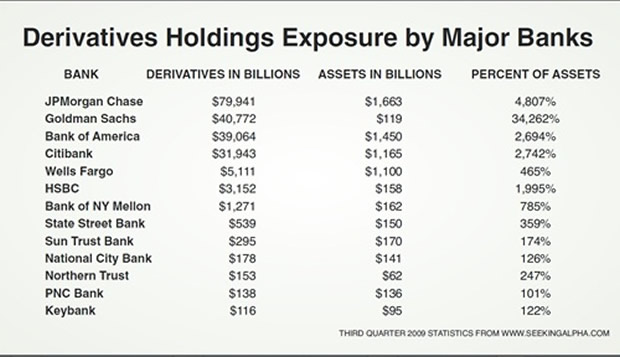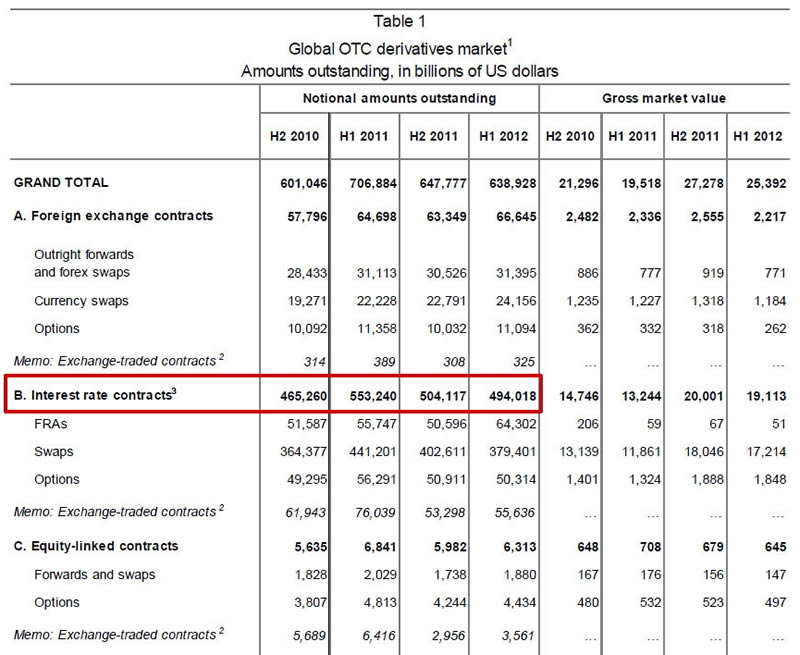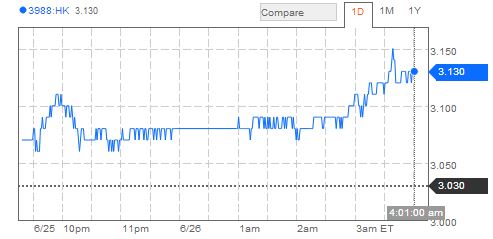Author: Elite Forex Blog - Market Research & Analysis
Bankruptcy Bail-Ins Are Retirement Accounts Next?


Collateral Transformation: The Latest, Greatest Financial Weapon Of Mass Destruction
FROM BLISSFUL IGNORANCE TO PARANOIA
The BIS report, “Asset encumberance, financial reform and the demand for collateral assets,” was prepared by a “Working Group established by the Committee on the Global Financial System,” which happens to be chaired by none other than NYFed President William Dudley, former Chief US Economist for Goldman Sachs. (No, he is not the Chief US Economist referred to earlier in this report, although as explained above these guys are all substitutes for one another in any case.) [2]
[A]s the financial crisis made painfully clear, the business of liquidity provision inevitably exposes financial intermediaries to various forms of run risk. That is, in response to adverse events, their fragile funding structures, together with the binding liquidity commitments they have made, can result in rapid outflows that, absent central bank intervention, lead banks to fire-sell illiquid assets or, in a more severe case, to fail altogether. And fire sales and bank failures–and the accompanying contractions in credit availability–can have spillover effects to other financial institutions and to the economy as a whole. Thus, while banks will naturally hold buffer stocks of liquid assets to handle unanticipated outflows, they may not hold enough because, although they bear all the costs of this buffer stocking, they do not capture all of the social benefits, in terms of enhanced financial stability and lower costs to taxpayers in the event of failure. It is this externality that creates a role for policy. [3]
[Newton’s] third law of universal motion was that for each and every action there is an equal and opposite reaction. While applicable to the natural world, it does not hold with respect to the actions of financial markets and the subsequent reactions of central banks and other regulators. Indeed, the reactions of regulators are consistently disproportionate to the actions of financial markets. In sinister dialectical fashion, the powers assumed and mistakes made by policymakers tend to grow with each crisis, ?thereby ensuring that future crises become progressively more severe…[W]as the Fed’s policy reaction to the 1987 crash proportionate or even appropriate? Was it “an equal but opposite reaction” which merely temporarily stabilised financial markets or did it, in fact, implicitly expand the Fed’s regulatory role to managing equity prices? Indeed, one could argue that this was merely the first of a series of progressively larger “Greenspan Puts” which the Fed would provide to the financial markets during the 18 years that the so-called “Maestro” was in charge of monetary policy and, let’s not forget, bank regulation…By the late 1980s, a huge portion of the S&L industry was insolvent. The recession of 1990-91, made a bad situation worse. FSLIC funds were rapidly depleted. But a federal guarantee is supposed to be just that, a guarantee, so Congress put together a bailout package for the industry. A new federal agency, the Resolution Trust Corporation (RTC), issued bonds fully backed by the US Treasury and used the proceeds to make insolvent S&L depositors whole…In retrospect, the entire S&L debacle, from its origins in regulatory changes and government guarantees, through the risky lending boom, bust, credit crunch and fiscal and monetary bailout can be seen as a precursor to the far larger global credit bubble and bust of 2003-2008: Just replace the S&Ls with Fannie/Freddie and the international shadow banking system. But there is no need to change the massive moral hazard perpetrated by incompetent government regulators, including of course the Fed, and the reckless financial firms who played essentially the same role in both episodes.[4]
MIGHT COLLATERAL TRANSFORMATION BE THE CRUX OF THE NEXT CRISIS?
PLAGARISED COPIES OF AN OLD PLAYBOOK
[2] The entire paper can be found at the link here (PDF).
[3] This entire speech can be found at the link here.
[4] FINANCIAL CRISES AND NEWTON’S THIRD LAW, Amphora Report Vol. 1 (April 2010). The link is here.
Europe Make Cyprus “Bail-In” Regime Continental Template
The European Union agreed on Thursday to force investors and wealthy savers to share the costs of future bank failures, moving closer to drawing a line under years of taxpayer-funded bailouts that have prompted public outrage.After seven hours of late-night talks, finance ministers from the bloc’s 27 countries emerged with a blueprint to close or salvage banks in trouble. The plan stipulates that shareholders, bondholders and depositors with more than 100,000 euros ($132,000) should share the burden of saving a bank.The deal is a boost for EU leaders, who meet later on Thursday in Brussels, and can show that they are finally getting to grips with the financial crisis that began in mid-2007 with the near collapse of Germany’s IKB.“For the first time, we agreed on a significant bail-in to shield taxpayers,” said Dutch Finance Minister Jeroen Dijsselbloem, referring to the process in which shareholders and bondholders must bear the costs of restructuring first.The rules break a taboo in Europe that savers should never lose their deposits, although countries will have some flexibility to decide when and how to impose losses on a failing bank’s creditors.“They can affect German savers just as well as they can affect any other investor in the world,” German Finance Minister Wolfgang Schaeuble said after the meeting.* * *But thorny issues lie ahead, not least whether countries or a central European authority should have the final say in shutting or restructuring a bad bank.The European Commission, the EU executive, is expected to unveil its proposal for a new agency to carry out this task of “executioner” as early as next week, officials said.“The most important discussion has yet to start and that is how decisions on restructuring will be made,” said Nicolas Veron, a financial expert at Brussels-based think tank Bruegel. “It’s premature to say that Europe is getting its act together.”Many Europeans remain angry with bankers and the easy credit that helped create property bubbles in countries including Ireland and Spain, which then burst and plunged Europe into a recession from which it has yet to recover.
http://www.zerohedge.com/news/2013-06-27/europe-make-cyprus-bail-regime-continental-template
Continue ReadingSome Hard Numbers On The Western Banking System
Submitted by Simon Black via Sovereign Man blog,
At our Offshore Tactics Workshop in Santiago three months ago, Jim Rickards (author of the acclaimed Currency Wars) told the audience of roughly 500 people– (paraphrased)
‘If one of you stands up right now and heads for the exit, the rest of the audience probably won’t pay much attention. If ten of you do it, one or two people may notice and follow. But if 400 of you suddenly head for the exit, the rest of the audience would probably follow quickly.’
It’s a great metaphor for how our financial system works. The entire system is based on confidence. And as long as most people maintain this confidence, everything is fine.
But as soon as a critical mass of people loses confidence in the system, then it starts a chain reaction. More people start heading for the exit. Which triggers even more people heading for the exit.
This is the model right now across the system. And it’s especially pervasive in the banking system.
Modern banking is based on this ridiculous notion that banks don’t actually have to hang on to their customers’ funds.
Banks in the United States typically hold less than 10%, and even less than 5%, of their customers’ savings. This is particularly true among smaller regional banks.
As an example, BB&T bank is holding about $3.2 billion in cash equivalents on $131 billion in customer deposits. That’s a ratio of just 2.4%.
The rest of customer deposits are mostly invested in residential mortgage backed securities (similar to those which collapsed in 2008) and commercial loans. In fact, the bank’s loan portfolio exceeds total customer deposits. Not exactly the picture of financial health.
In the UK, the situation has become so absurd that British regulators are allowing some banks (Lloyds, Royal Bank of Scotland) to plug their gaping capital deficits with FUTURE earnings.
Now, I’m not trying to badmouth any particular bank here; these example are representative of the entire western financial system.
Yet few people give much thought to where they park their hard-earned savings. We’re deluded into believing that our bank is safe. It must be, after all. It’s a bank! And… it’s backed by the government!
Sure, never mind that the balance sheets of insurance funds and sovereign governments are in even worse shape.
That this system is still functioning at all is due almost entirely to confidence. There is no fundamental support propping it up. And a system built exclusively on confidence can unravel quickly.
This is why it’s so important to give a lot of thought to your financial partner. Do they have a fundamentally safe balance sheet? Or is it just smoke and mirrors?
Take a look at your own bank’s balance sheet. How much cash do they hold as a percentage of deposits? How big is the loan portfolio as a percentage of deposits? How much equity does the bank have as a percentage of deposits?
If you’re not satisfied, find another bank. And you may have to look overseas at stronger jurisdictions.
Singapore is one place where I’m happy to park capital. OCBC for example, holds a whopping 38% of customer deposits in cash equivalents… ten times as much as many banks in the West.
Its total loan portfolio is far less than customer deposits. Total equity exceeds assets by a margin of 2:1. And it resides in a nation with effectively no net debt.
I’m not necessarily endorsing OCBC, but rather citing it as an example of what a healthy bank balance sheet is supposed to look like. Many banks in Singapore hold similar figures.
Bottom line, it matters where you hold your savings. Balance sheet fundamentals are critical.
And moving your hard-earned savings to a well-capitalized, highly liquid bank is one of those things that makes sense, no matter what.
If nothing happens, you won’t be worse off for it. Yet if the confidence game collapses, you’ll be one of the few left standing with your savings intact.
Continue Reading Major Chinese Banks Stop Lending
“Time Is Running Out Fast” For Italy
“Time is running out fast,” said Mediobanca’s top analyst, Antonio Guglielmi, in a confidential client note. “The Italian macro situation has not improved over the last quarter, rather the contrary. Some 160 large corporates in Italy are now in special crisis administration.”The report warned that Italy will “inevitably end up in an EU bail-out request” over the next six months, unless it can count on low borrowing costs and a broader recovery.Emphasising the gravity of the situation, it compared the crisis with when the country was blown out of the Exchange Rate Mechanism in 1992 despite drastic austerity measures.…“The European Central Bank needs to take very aggressive steps to offset this,” said Marchel Alexandrovich from Jefferies Fixed Income. “We have a sell-off across the board. If the ECB doesn’t act, it could see all the gains of the past nine months vanish in two weeks, taking the eurozone back to square one.”…“We have clear signs in global finance of a generalised meltdown in assets right now.”…Mediobanca said the trigger for a blow-up in Italy could be a bail-out crisis for Slovenia or an ugly turn of events in Argentina, which has close links to Italian business. “Argentina in particular worries us, as a new default seems likely.”Mr Guglielmi said Italy’s industrial output has slumped 25pc from its peak in the past decade, while disposable income has dropped 9pc and house sales have dropped to 1985 levels.The 1992 crisis was defused by a large devaluation, allowing Italy to restore trade competitiveness at a stroke. Mediobanca said: “The euro straitjacket is clearly not providing a similar currency flexibility today. With the lira devaluation Italy managed to inflate debt away, which it cannot do today. It could take more than 10 years to revert to pre-crisis output levels.
http://www.zerohedge.com/news/2013-06-25/time-running-out-fast-italy
Continue ReadingBank Of China Declares Moratorium On Transfers, Online Banking; Counters Inoperable
From Caijing, google translated. We hope the gist of the narrative in Mandarin is far less scary, because if the translation is even remotely accurate, then all hell may be about to break loose in China.From Caijing: Bank of China, Bank of suspens…
Continue ReadingBIS says central banks must stop supporting economy
The Bank for International Settlements (BIS) says banks have done their bit to help economic recovery and governments must do more.The Basel-based organisation – usually dubbed the “central banks’ central bank” says it is time for them to stop pum…
Continue ReadingLiquidation – Stocks, Bonds, Commodities Collapse
The International Monetary Fund is preparing to suspend aid payments to Greece by the end of next month unless eurozone leaders plug a €3bn-€4bn shortfall that has opened up in Greece’s €172bn rescue programme, according to officials involved in management of the bailout.The gap emerged after eurozone central banks refused to roll over Greek bonds they hold, and comes amid signs that even the scaled-back privatisation plan Athens agreed to last year is falling behind schedule.…The shortfall will force eurozone finance ministers to discuss “alternate sources” of funding…But the timing is particularly awkward as Germany is holding parliamentary elections on September 22. In the run-up to polling day Chancellor Angela Merkel will be loath to submit any further aid request to the Bundestag where it would likely be highly controversial.…the IMF has warned EU officials the gap will require it to stop aid payments at the end of July, said a person involved in the discussions.Under its rules, governments must have at least 12 months of financing in place to receive IMF disbursements under a bailout programme. This latest shortfall of €3bn-€4bn means that Greece’s financing needs are only covered up to the end of July 2014.
http://www.zerohedge.com/news/2013-06-20/stocks-plunge-imf-tells-greece-plug-holes-or-it-pulls-plug
Continue Reading





